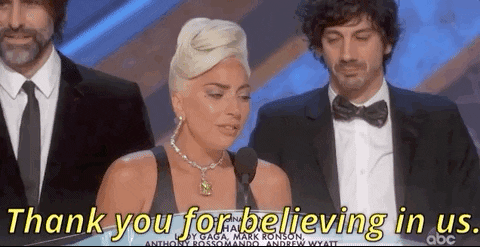Most Shared
Lady Gaga gets best possible revenge on ex-classmates who bullied her with a Facebook group.
05.08.19

via Shutterstock
We've all heard the saying "haters make me famous," but few celebrities have lived that truth as precisely as Lady Gaga.
While it's well-known by now that she believes you just need one person in a room of 100 to believe in you, this mantra isn't just PR positivity, but comes from personal experience.
"When I was a freshman at NYU and Facebook was only a year old and people created/joined groups like "I have dimples, f*** me" and "Fake ID, please!," I remember coming across a Facebook group that broke my heart. It's name: "Stefani Germanotta, you will never be famous.
The page housed pictures of a pretty Norah Jones-esque young 18-year-old NYU student who sang and played piano at local bars. The group was peppered with comments, sharp as porcupine needles, vilifying the aspiring musician for being an "attention-whore." Scores asked: "Who does she think she is?" I also remember one dude posting a flyer for one of her upcoming gigs at a local village bar. He had clearly stomped on the flyer, an outline of his muddy sole [soul] struggling to eclipse her name.
I couldn't shake the raw feeling of filth while scrolling down that Facebook page, but I pretty much -- and quickly -- forgot about that group and that girl with the intense raven eyes.
Until about five years later. I was on an Amtrak train from NYC to Philly, reading a Vanessa Grigoriadis New York Magazine profile on Lady Gaga. I floated somewhat mindlessly through the piece until I got to the first sentence of the second graf:
Before the meeting, I assumed that someone with a stage name like “Lady” (her given name is Stefani Joanne Germanotta) was going to be a bit standoffish..."
HOLY SHIT, I screamed to an empty car (Those who hang with me will know that I actually shrieked). LADY GAGA IS STEFANI GERMANOTTA? STEFANI IS LADY GAGA?
I was overcome with a dizzying emotional cocktail of stage-mom-at-a-beauty-pageant and nerd-revenge triumph. But also shame. Shame that I never wrote on that group, shame that I never defended the girl with the intense raven eyes -- the girl whose brave flyers were stomped on, probably somewhere near my dorm.
But again, I soon forgot about that revelation and that feeling. Feelings. They're so fleeting. Even more so, revelations. We need to constantly re-discover them every damn day. Like last week, when I woke up to this meme. I saw the muddy sole eclipsing her name. The eye-rolls. The cowardly virtual-giggles. The "Who does she think she is?""
I've got a lot of feelings, but the easiest one to articulate: gratitude. Stefani, thank you. Thank you for always thinking you're a superstar, for using your cracks to let the light come out more brightly. Humans, let's follow suit. #LadyGaga #ThatsWho"
People are legitimately curious about how those 12 Facebook Members feel about their petty cruelty now.
Others noted how this just exemplifies that people will hate on anyone and any project, and that should never be a reason to stop.
This article was originally published by our partners at someecards.
From Your Site Articles
- Lady Gaga's dog-walker is recovering after assailants shot him and stole her two French bulldogs - Upworthy ›
- 7-year-old makes motivational videos for his 2nd grade class - Upworthy ›
- A woman stood up the man who bullied her as a teen - Upworthy ›
- Led Zeppelin 'Stairway to Heaven' tribute from 2012 - Upworthy ›
- Dad didn't force his son to apologize after bullying someone - Upworthy ›
- Lady Gaga fans beg her to make 'Pip' song from SNL her next single - Upworthy ›
- Farmer gets perfect revenge on guy who dumped 420 tires on his property - Upworthy ›
- Lady Gaga donates money to schools in cities affected by mass shootings - Upworthy ›
- A British farmer caught someone dumping 421 tires on his land. His revenge was poetic justice. - Upworthy ›
- It's official, even rats love Lady Gaga. It's science! - Upworthy ›




